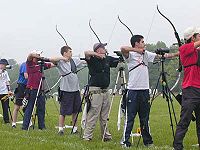Modern competitive archery
[1] However, in modern times, most archery targets are made of synthetic foam, or woven plastic bags stuffed with cloth.Field archery involves shooting at targets of varying (and sometimes unmarked) distance, often in rough terrain.One goal of field archery is to improve the technique required for bowhunting in a more realistic outdoor setting, but without introducing the complication and guesswork of unknown distances.It is most common to see unmarked distances in 3D archery, as the goal is to accurately recreate a hunting environment for competition.Some competitors will travel thousands of miles (kilometers) a year to compete to try and claim the world title in 3D archery.The major 3D archery groups are the IBO (International Bowhunting Organization) and the ASA (American Shooters Association) are primarily based in Eastern United States.Similar to target archery, except that the archer attempts to drop arrows at long range (180 yards or 160 metres for the men and 140 yards or 130 metres for women; there are shorter distances for juniors depending on age) into a group of concentric circular scoring zones on the ground surrounding a marker flag.By following the detailed guidelines issued by the IAU's Technical Committee it is possible to construct a field crossbow from locally available archery materials and target shooting accessories.Crossbow archers shoot from the standing position and they must draw the bow string by hand without mechanical assistance.At outdoor competitions Bolts (arrows) are shot in "ends" (series) of three at multi-coloured 10-zone archery target faces.After a sound signal from the official in charge of shooting, all competitors walk forward together to score and collect their bolts from the targets.It requires a large flat area such as an aerodrome; the Ottoman Empire established an "arrow field" (Ok-Meidan) in Istanbul and there were others in several major cities.At the end of the shoot, archers stay by or mark their furthest arrows while judges and their assistants measure the distances achieved.A bow with modern material is allowed for lower level of archers however higher level of archers who have officially recorded more than 30 hit out of 45 arrow need to use a bow and arrow made with traditional material such as sinew, horn and bamboo.Traditionally, archers stand within 12 feet (3.7 m) of the bottom of a 90 feet (27 m) mast and shoot almost vertically upwards with 'blunts' (arrows with rubber caps on the front instead of a point), and 'flu-flu' fletchings (very large, wound round the shaft to quickly reduce speed and distance of flight) the object being to dislodge any one of a number of wooden 'birds'.A horizontal variation with Flemish origins also exists and is also practiced in Canada and the United States A Papingo is also hosted during the summer in Scotland by the Ancient Society of Kilwinning Archers."Hoyles" are marks that are chosen at the time from the variety of debris, conspicuous weeds, and so on found in most outdoor areas.Archers take turns shooting at a vertical strip of wood, the wand, usually about six feet (1.8 m) high and three to six inches (7.6 to 15.2 cm) wide.As the target is a long vertical strip this competition allows for more errors in elevation, however since no points are awarded for near misses the archer's windage accuracy becomes more important.[5] Archers often enjoy adding variety to their sport by shooting under unusual conditions or by imposing other special restrictions or rules on the event.Some forms include the broadhead round, bionic and running bucks, darts, archery golf, night shooting, and turkey tester.Combat archery can be an interesting challenge for participants, as it involves shooting at moving targets, and can be used to re-create battles.For example, organising bodies for competitive archery prohibit activity that involves deliberate shooting in the general direction of a human being.[10] The separation between the worlds of competition archery and the impalement arts is more marked than that between, for example, knife throwing as a sport and as an entertainment.[11] However archery involving a person in the vicinity of the target is a particularly dangerous practice and, even with very experienced performers, there have been cases of very serious injury.Howard Hill used his extraordinary accuracy for the archery in the movie The Adventures of Robin Hood (1938) starring Errol Flynn.He used a heavy hunting bow to hit small reinforced target areas on the chests of actors in motion.







Two papingos in the Kilwinning Abbey tower museum, Scotland.

accuracy and precisionarcherytarget archeryEuropeNorth AmericaSouth Americafield archeryWorld Archery Federationgoverning bodyInternational Olympic Committeemarsh grassClout archeryLandshutcrossbowOttoman EmpireIstanbulTurkish flight archerybiathlonrun archeryKyūdōPopinjay (sport)PopinjayFlemishwindagearchery gameshistorical reenactmentKentuckyEducationFish and Wildlife ResourcesImpalement artscircusesWild West showsknife throwingApacheSociety for Creative AnachronismarrowsarmouredwarriorsknightsHoward HillThe Adventures of Robin HoodSummer Olympic GamesSummer Paralympic GamesWorld GamesAsian GamesCommonwealth GamesArchery at the Summer OlympicsArchery at the Summer ParalympicsArchery at the World GamesGrand National Archery SocietyShooting Sports2009 World Indoor Archery ChampionshipsWorld ArcheryHistoryChineseJapaneseTurkishHistory of crossbowsWorld Archery RankingsArcher's paradoxMounted archeryBallista elephantYabusameBow shapeArbalestAustroasiatic crossbowCable-backed bowComposite bowCompound bowEnglish longbowFlatbowGakgungHolmegaard bowLaminated bowLongbowMongol bowRecurve bowSelf bowTakedown bowWelsh bowArrowheadBowstringBracerCresting machineFinger tabFletchingFlu-flu arrowRelease aidQuarrelQuiverThumb ringBowfishingBowhuntingBowyerOlympicsWorld ChampionshipsWorld CupParalympicsUniversiadeWorld University Archery ChampionshipsMilitary World GamesAfricaAmericasGlossary